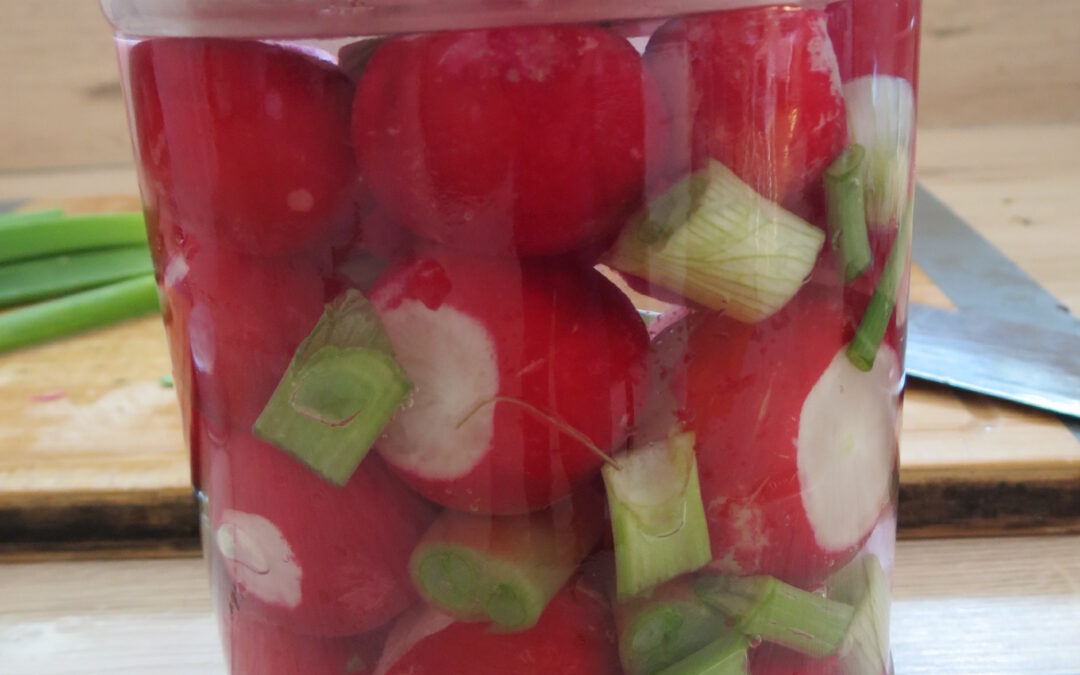
by Angela Braun | Apr 5, 2024 | Preserving
Radishes are one of the earliest vegetables to be harvested in spring. With a cultivation time of just 3 – 4 weeks, they can be ready to eat by beginning to mid-April, if we sowed them early enough, maybe even in the greenhouse. One of my greatest delights in spring is to make a large salad bowl and add the first radishes, freshly harvested from the greenhouse. But radishes are also great for fermentation. Here are two of my favourite recipes for fermented radishes:
Fermented radish slices
Dry-salting technique
You can make this recipe with any variety available. Red varieties, however, are particularily pretty.
Ingredients
1,5 kg radishes, thinly sliced
1 tbsp unrefined salt
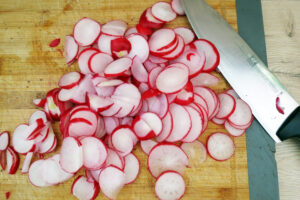
Instructions
1. Put the radishes into a bowl and mix them with half the amount of salt. Rub the salt in well and taste the radishes: they should be salty but not too much. If necessary, add some salt. The radishes become wet and soft and slowly a brine builds.
2. Now, put the radishes portion by portion into the fermentation container of your choice and press them tightly with your hands or a tamper into the jar to avoid air bubbles. There should be enough brine to cover the radishes. Leave about 2 cm to the lid, put a weight onto the radishes so they stay under the brine and close the container.
3. Put the bowl onto a tray and let the radishes ferment for 5 – 14 days at a cool place without direct sunlight. Make sure that there’s always enough brine.
4. Taste the radishes after 5 days. If they are ready, store them in the fridge, if not, leave them out to ferment further until you like the taste. You can store the fermented radishes in a cool basement for up to 6 months.
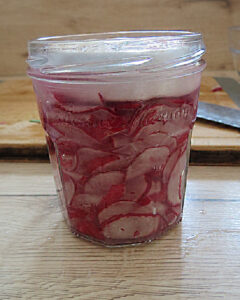
Whole fermented radishes
Brine technique
Ingredients
1 – 2 bundles of radishes, cleaned
3 – 4 spring onions (only the white part)
For the brine
1 tbsp unrefined salt
1 tsp sugar
1 l Water
Instructions
1. Wash the radishes and spring onions in cold water and put them into the fermentation container of your choice. Make sure the vegetables are stacked tightly.
2. For the brine, dissolve the salt and sugar in the water and pour so much brine over the vegetables until they are fully covered. Store the brine (up to one week) in the fridge. Secure the lid on the fermentation container.
3. Put the bowl onto a tray and let the radishes ferment for 7 – 10 days at a cool place without direct sunlight. If too much brine evaporates, fill up with the brine in your fridge.
4. In the course of the fermentation process, the radishes will lose their colour and the brine becomes opaque. Now it’s time to taste.
5. If you are satisfied with the taste and want to eat them right then, store the radishes in the fridge. If not, leave them out to ferment further until you like the taste. You can store the fermented radishes in a cool basement for up to 6 months.
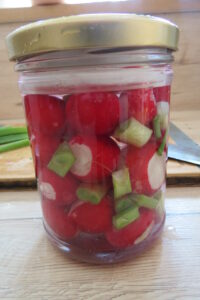
Variations
You can play with adding further herbs and spices to your radishes, for example ground coriander or minced garlic. If you like it hot, add some chilli flakes or grated ginger. Lemon peel makes also a great and interesting taste. Become creative!
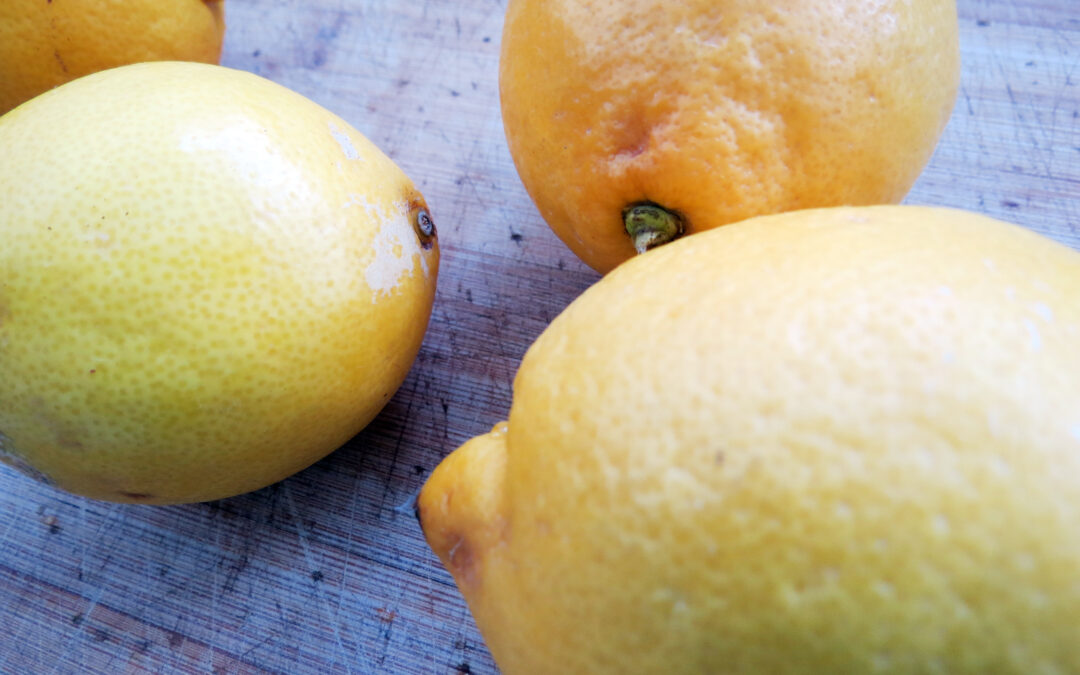
by Angela Braun | Apr 5, 2024 | Preserving
When I first heard about fermented lemons, I wondered what you could use them for. After all, if you wanted to taste something salty, you’d simply add salt, wouldn’t you? And if you wanted a dish to taste more lemony, you’d add lemons, right? But like so often, you have to try something to form an opinion. I’ll never forget the moment I first tried fermented lemons: the taste of the lemons was so enhanced, yet neither too acidic nor too salty. It was bursting with flavour and (for a short time) it rendered me speechless. A whole new world of taste had opened up and I had to have them at home. You’ll be delighted to hear that it is super-easy to make fermented lemons by yourself!
Fermented lemons
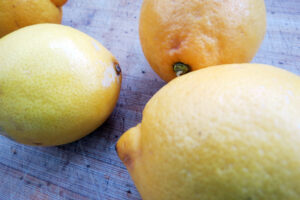
Ingredients
8 whole lemons, organic!
90 – 150 g unrefined salt
2 tbsp freshly squeezed lemon juice as necessary
Instructions
- Wash the lemons in cold water, cut off the fruits’ edges (about 5 mm) and cut the lemons lengthwise twice almost (!) through. If you’ve done it right, your lemons have four wedges that are held together at the bottom. Remove the pips and put the lemons into a bowl. Sprinkle the salt into the cuttings and around the lemons.
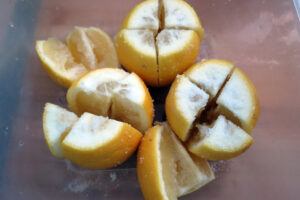
- Press the lemons into your fermentation container so that the brine shows on the surface. If the lemons are not completely covered, add some lemon juice. Sprinkle the surface with 2 tbsp salt, put a weight in so that the lemons stay under the brine and close the container.
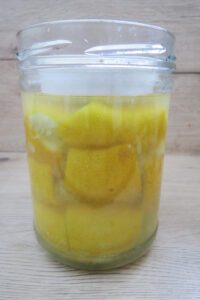
- Put the container onto a tray and let the lemons ferment for 21 – 30 days at a cool place without direct sunlight. Check from time to time if they are still covered with brine.
- After 21 days, the fermented lemons are ready, but you can let them ferment longer which only adds to the taste. With time, the brine becomes a bit thicker and the lemon flavour intensifies.
- Store the fermented lemons in the basement or the fridge for up to 18 months.
Variations
Add spices to your fermented lemons such as cinnamon sticks, cloves, coriander seeds, peppercorns, juniper berries or bay leaves. Or you can try out limes instead of lemons and add onions, garlic, coriander seeds, cilantro and chillis. There are still so many variations to try. If you’ve further ideas, leave a comment below.
If life gives you lemons – ferment them! 😉
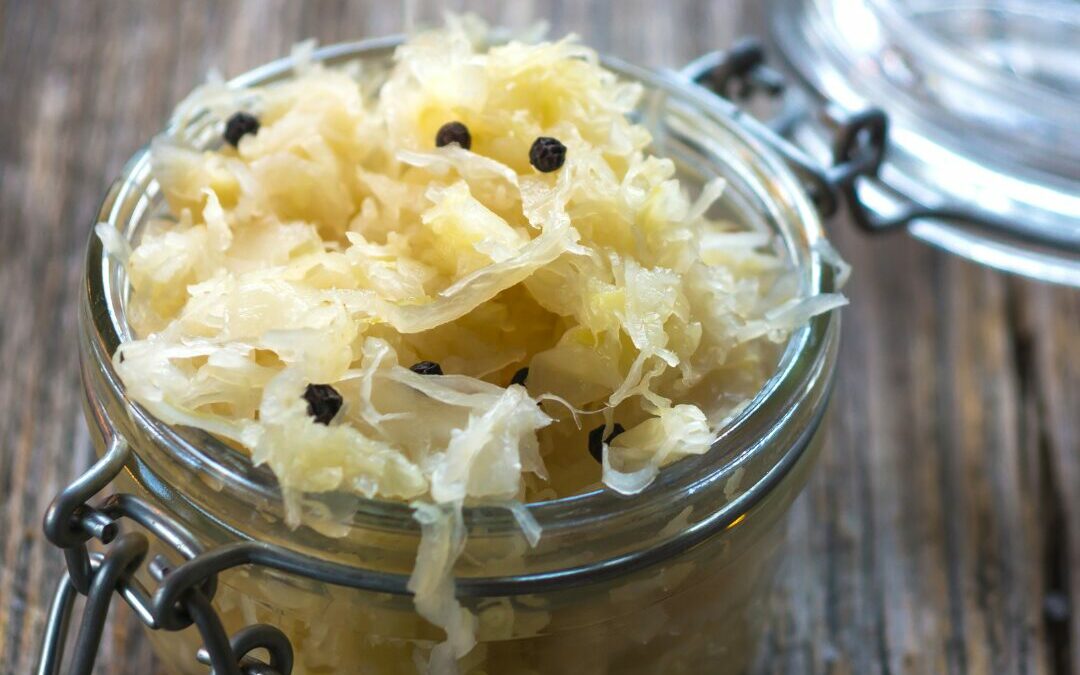
by Angela Braun | Apr 3, 2024 | Preserving
Do you remember your granny going down into the basement and getting sauerkraut from a larger crock? No? Me neither – although I’ve grown up on a farm in rural Germany. Fermentation wasn’t „cool“anymore at that time and it was far more common to can your vegetables or store them in the freezer.
For several years now, the trend has gone back (or should I say “forward again”?) to fermenting food. And thank God for that! Fermentation has been a standard preserving method for thousands of years and it has so many benefits to our health and environment. But what exactly is fermentation and how can you ferment vegetables?
What is fermentation?
When hearing “fermentation”, most people will think about fermented vegetables like sauerkraut or kimchi. But there is a lot more to it! Sourdough, for example, is also a ferment. So are yogurt and kefir. And have you heard of Kombucha? Yep, also a ferment.
According to Wikipedia, fermentation is “a metabolic process that produces chemical changes in organic substances through the action of enzymes.”
That means, by feeding bacteria that are naturally present on fruit and vegetables and that we want to increase, we obtain food that is way more nutritious than the raw vegetables, tastes wonderful, and can be preserved for months (even years). The process where naturally present bacteria on the vegetables are used is called Wild Fermentation.
The science behind fermentation
When it comes to fermentation, we need certain bacteria and must prevent others. The most important of the “good” bacteria we need for fermentation is called lactobacillus. Lactic acid bacteria are practically everywhere: on vegetables, on our skin, and in our house, which is great for wild fermentation. During this process, they transform carbs into lactic acid and carbon dioxide (CO2) and prevent damaging bacteria from growing. Other important bacteria for fermentation are staphylococci and micrococci.
It depends on factors such as temperature, initial bacteria distribution, and oxygen which bacteria increase. If the fermentation happens without oxygen, these are the lactic acid bacteria, a fact we use to produce marvelously tasting fermented food.
There are three types of fermentation:
Wild fermentation
The process where naturally present microbes on foods or in the air are used for fermentation, especially if it occurs spontaneously, is called wild fermentation! Creating a sourdough starter, for example, is a wild fermentation process as it works with wild yeasts from the air. Another example of wild fermentation is sauerkraut. The naturally present microbes on the cabbage start (with salt and without oxygen) a fermentation process.
Lacto-fermentation
This is practically the same as wild fermentation, but it refers to the specific bacteria lactobacillus which is present on anything grown in the earth. Lactobacillus feeds on sugar and transforms it into lactic acid. Sauerkraut then is an example of both, wild and lacto-fermentation.
Culturing
Culturing means that to start a fermentation process you add a starter culture. Think of kefir, where you use water kefir grains, or kombucha where the SCOBY is responsible for fermentation. Another example of culturing would be yogurt. You either add some yogurt or yogurt starter cultures to the milk to start the fermentation process and make it yogurt.
Benefits of fermentation
Health benefits

Maybe you’ve heard the story of Captain Cook who prevented scurvy by making his crew eat sauerkraut every day. We know today that scurvy is caused by a severe vitamin C deficiency due to a limited diet. We also know now that the vitamin C content of vegetables increases through fermenting, as well as the content of other vitamins and minerals. That makes fermented goods a super-booster for our immune system.
Science has also found out that the iron content in lacto-fermented vegetable juices is to a certain extent better soluble than that in raw juice.
Additionally, vitamin B12 and folic acid can be found in fermented vegetables. As the only other sources for these nutrients are of animal origin, this is especially interesting for vegetarians and vegans.
Fermentation also eliminates various toxins such as polyphenols, citates, and tannins.
There is a connection between the ingestion of probiotics through fermented food and a reduction in blood pressure.
Fermented food can also help regulate inflammation in the gut and boost anti-inflammatory cytokines
And, last but not least, fermented goods help to improve digestion.
Environmental benefits
Despite all the amenities of modern life such as freezers, fridges, and canners, one-third (!) of food is still thrown away, most of it in the Western world. According to studies, 90 kilograms of food are thrown away per capita in Western Europe. Fermenting vegetables instead of storing them in the fridge till they are wilted, is a good way not only to reduce food waste but also to produce healthy food that lasts for months.
Another benefit of fermentation is that it does not require electricity. All the energy you need is a bit of muscle to chop and slice the vegetables and press them into a jar.
If you ferment vegetables that you have grown yourself or bought locally, you make sure to keep transportation routes short.
How does fermentation work?
There are two methods of lacto-fermentation
The brine method
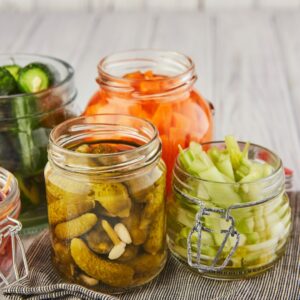
Here, chopped or whole vegetables like carrot and cucumber sticks or cauliflower roses are put into a jar which is then filled up with brine until the vegetables are completely covered. Brine is essentially a water-salt solution with 25 – 50 g salt per liter of water, depending on the vegetables. Put the containers in a place without direct sunlight and temperatures between 13 and 24 °C and let the content ferment. If necessary, fill up with brine. The time of fermentation depends on the recipe.
The dry-salting method
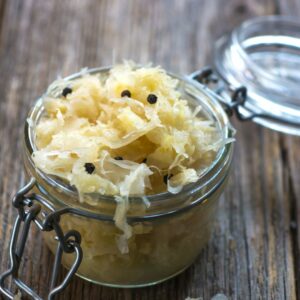
Despite the name, this process is not dry. The vegetables are sliced as thin as possible and mixed with salt. Slicing breaks up the cell structure so that the salt can act more effectively and draw water out from the vegetables that gathers as brine. Tightly press the vegetables into your containers and fill up with the remaining brine. Let sit at a place without direct sunlight at a temperature between 13 and 24 °C. The time of fermentation depends on the recipe.
The role of salt in fermentation
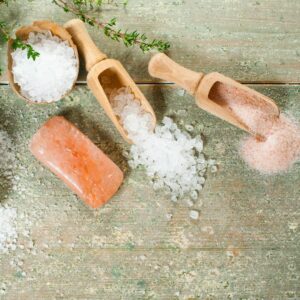
Salt can preserve fresh vegetables, including all their vitamins for months or even years. It removes water from the cells which gathers as brine in the fermentation crock. Brine again is important as lactic acid bacteria live anaerobic, i.e. without oxygen which lots of other microbes need. To prevent the growth of those unwanted microbes, fermentations happen under the exclusion of oxygen, that is: in brine.
Salt also improves the consistency of the vegetables. It hardens the cells’ pectin so that they stay more stable and thus “crunchy”.
It may come as a surprise, but salt makes salty and thus adds to the taste.
It also helps to keep unwanted bacteria and yeasts in check that are more sensitive to a salty environment than lactic acid bacteria.
Without salt, there could be an increase of yeasts that transform sugar not into lactic acid but into alcohol.
Which salt to use?
For my fermented vegetables I only use natural salt that is rich in minerals but does not have any additives:
Rock salt
Himalayan salt or Redmond real salt are residues of prehistoric oceans. In the course of millions of years and under heat and pressure salt crystals rich in minerals were formed. The crystals are slightly pink and you can buy them finely ground. Rock salt does not dissolve completely in the brine but the residues sink to the bottom of the container and do not affect the quality of the fermented food.
Sea salt
The most common unprocessed sea salts are “Sel gris” (French for grey salt) and “fleur de sel” (French for salt flower). Both types are gathered by letting seawater evaporate in large basins until only the crystallized salt remains – together with residues of plankton, minerals, and micronutrients. These salts have a higher moisture content and are very mild in taste which makes them wonderful for fermentation. However, we can mostly buy them only as crystals which makes it a bit difficult to dissolve and form brine. To make it easier, you can always grind the crystals in a food processor or a mortar.
Iodized salt
There have been many discussions about the influence of iodized salt on the fermentation process. Some people believe that it hinders the lactic acid bacteria, and some say the iodine content is way too low to have any impact. I don’t use iodized salt.
Kosher salt
This salt is often recommended for fermentation as the flaky crystals have a large surface and thus can withdraw water well from the cells. Despite the fact, however, that kosher salt must not have any additives like iodine, it is highly processed. For that reason, I don’t use kosher salt.
Fermentation conditions
There are a few factors that are crucial for a successful fermentation:
Hygiene
Before you start fermenting, wash your hands thoroughly with warm water and soap. Don’t use antibacterial soap as this could inhibit the fermentation process – especially if you knead the cabbage. Wash your vegetables just with cold (!) water and don’t sterilize your equipment as this could kill our lactic acid bacteria. Just warm water and a bit of soap is enough to clean your equipment.
Temperature
I recommend a temperature between 13 and 24 °C for fermentation as this is the range where lactic acid bacteria thrive. It’s important to keep the temperature constant. The warmer it is, the faster acid is produced. If it’s too warm, however, the microorganisms can’t develop quickly enough, and the taste will suffer.
If it’s too cold (especially at the beginning), the lactic acid bacteria can’t increase fast enough which may lead to spoilage.
Light
A dark place is ideal for fermentation. This doesn’t mean that you have to store your fermentation crock in a pitch-dark hole, but it should also not be in direct sunlight. A shadowy corner in your kitchen or pantry where you can have an eye on it is great.
Oxygen
As talked about earlier, fermentation happens without oxygen, so we must make sure that the vegetables are always under the brine. With the brine technique, this can mean that we have to add brine after several days. When applying the dry-salting technique, we can make sure that our veggies are constantly covered with brine by putting a weight on them and pressing them down.
Time
So, how long does it take until the fermentation process is complete and you can eat your fermented veggies? That depends, mostly on the kind of vegetables but also on other factors like temperature and season. Technically speaking, veggies are fermented when they have reached a pH of under 4.6 (a pH of 7 is neutral and the lower the pH, the more acidic the medium). If you want to determine the pH, go ahead and put a pH test strip into the brine. But you can also just rely on your taste buds: try your fermented food and eat it when you like the taste.
Storage
Now that your fermented food is ready, how do you and how long can you store it?
How long can I store fermented food?
Unfortunately, there’s no definite answer to that. It depends on the acid that has formed in the fermented food. Some like very shortly fermented food that may not have reached a pH of below 4.6. If you want to store it, however, it should be sufficiently sour. If you’re not sure, test the pH with an indicator test strip.
You must keep in mind that fermented food is alive and therefore other rules apply than for, let’s say jam. Jam is safely stored in its glass jar and only if you open it will the decaying process start. Fermented food, however, is subject to constant change. Even when stored cold, the food will constantly become more acidic, however long it takes. But this doesn’t mean that it will become bad: as long as it tastes good, everything’s alright.
By rule of thumb, fermented food lasts between 6 and 12 months. I had to throw out some glasses before that time because their content had gone bad, but I also have a two-year-old pepper salsa that has become even better.
Where to store fermented food
Many people recommend, storing it in the fridge when the taste is to your liking. The cool temperature brings the fermentation process (almost) to a standstill and keeps the taste that you like. But a fridge is expensive and needs electricity.
If you are lucky and have a cool (below 10 °C but above 0°C) basement or even a root cellar, this is a great storage place for your fermented food! In that case, I recommend fermenting in larger containers because the food lasts longer the larger the container is. It is no coincidence that people used large fermentation crocks in the past.
Alternatively, you may preserve your fermented food in a water bath. With this method, you must be aware that precious vitamins and nutrients may be destroyed by the heat.
My basement is luckily very cool and I can store all my fermented food there. If your cellar is too warm for that, I recommend a second fridge.
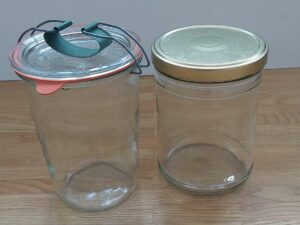
by Angela Braun | Apr 3, 2024 | Preserving
You wanna start fermenting and dread what you have to buy for it? No worries! The cool thing about fermentation is that you don’t need any fancy fermentation equipment. A bowl, a cutting knife and board, glass jars or other containers as well as a weight to press the vegetables under the brine are enough to start. Let’s have a look at the basics you need and some of the fancy stuff you might want to buy later:
Fermentation equipment: Containers
First of all, please make sure that you don’t use any containers made of metal or plastic. Metal reacts with acid which can lead to a dissolving of metals into the brine. This can cause serious health problems! The same applies to plastic: not all plastics are acid-resistant. The softer the material the stronger it reacts to acid. If you use freezer bags as weights, make sure they don’t contain PVC or BPA.
Fermentation crocks
Traditional fermentation crocks have proved their worth as they store the vegetables dark and cool. If you buy a new one, check out its net weight as they are usually very heavy. Then add the weight of the vegetables and brine and think about if you can lift it when it’s full.
Glass jars and lids

I usually use twist-off or flip-top jars. They are cheaper than crocks and you can ferment smaller portions. Additionally, you can see through the glass what’s going on inside. On the other hand, it’s more likely that brine will bubble over the rim and you’ll have to put it on a dish or into a bowl to prevent a mess.
Airlock systems grow in popularity because they make things a whole lot easier. With an airlock, you can leave the whole thing to itself. You must make sure, however, that you leave enough space from the top of the brine to the top of the glass jar, at least 2 – 3 fingerbreadths.
Note: I know that many people just use clean cloth to cover their jars or open the jars every day during fermentation but the risk of mould-forming is so much higher with these methods! I always use the lid and – in case of twist-off jars – secure it loosely or – in case of flip-top jars – secure it tightly. The gases can leak out either under the lid or the rubber ring and you minimize the risk of mould-building.
Cutting devices
It’s great if you have a cabbage slicer as part of your fermentation equipment, especially when you want to make sauerkraut or ferment other cabbages. As the name indicates, it’s great for cabbage slicing and it’s way faster than cutting cabbages with a knife.

If you’re just starting, however, you don’t need a slicer as you can also do the job with a knife and a cutting board.
I know that some people use the cutting or grating device of their kitchen machine. Go ahead if you like, but make sure that the slices are not too thin and mushy.
Bowls
Nothing to add: you just need a bowl of any kind (glass, metal or plastic) where you can gather all your sliced vegetables and mix them or knead them if you make sauerkraut.
Weights
Some people don’t use weights for fermentation, but I find them extremely helpful to keep the vegetables under the brine. Crocks usually come with suitable weights but if you don’t have any, you can use a dish for example.
You can also use stones but depending on their lime content they might react with the acid. You should at least boil them for 10 minutes before using.
There are also glass weights which are great, especially regarding hygiene. They are, however, comparatively expensive.
For beginners, I recommend using freezer bags. Fill them with water or pebbles and put them onto the covering (e.g. a cabbage leaf) to keep the veggies under the brine.
As I ferment a good deal and neither wanted to add to the waste with all those freezer bags nor wanted to sell my soul for good fermentation weights, I decided to make my own out of clay. I cut out circles of a 1 cm thick slice of clay, making their diameter slightly less than the opening of my jars. Then I cut a hole in the middle and glazed and baked the clay weights. During baking, they shrank a bit further and now their size is perfect for my jars.
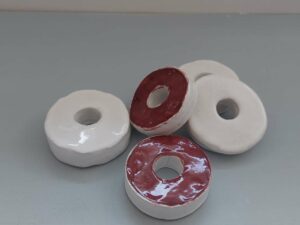
You can also make weights from hardwood that doesn’t secrete resin like walnut. Keep in mind, though, that wood swells in brine! Saw a circle with a diameter of one centimeter less than the opening and drill a hole into the middle where the brine could get through. Put the wooden weight into water for one to two days and look how much it swells before you use it. I’ve never used them as I find the clay weights perfect for my needs but go ahead and try making wooden weights if you like and leave me a comment about it!
Tamper

Again, it’s great if you have a wooden cabbage tamper to squeeze the cabbage (or other vegetables) into the jars really tightly, but it’s not necessary to start fermenting. You can always use your hands or a (clean!) empty bottle to press the vegetables into your containers.
I’m sure you’ll find all the necessary fermentation equipment in your kitchen and don’t have to buy anything new. You can always add fancy things to your birthday list 😉 Let’s start fermenting!

by Angela Braun | Apr 3, 2024 | Preserving
Fermenting your vegetables is a marvellous way to preserve your harvest. Not only that but it can also be easily done. You don’t need any fancy equipment or ingredients, just your vegetables (or fruit) and a bit of salt.
But although it’s easy for you to initiate fermentation, the process itself is complex and thus certain problems may arise.
In this article I describe some of those fermentation problems and what you can do about them.
The fermented food is too salty
Well, that happens all to often, I’m afraid. To avoid that beforehand, you should add the salt to your vegetables in portions and taste them before you put them into your fermentation containers. When it tastes good to you, but you still have some salt left: don’t add it. It’ll be fine and taste wonderful.
If the veggies are already fermented and now you realize they are too salty, you could try taking out the portion you want to eat and putting it into a bowl with clear water. Drain it and repeat this process until all the salt has been washed out. Let it drain in a sieve (plastic or acid-proof metal) for 15 minutes and taste it. If it’s still too salty to eat, compost it or – better still – put it onto a part of your garden that’s crowded with weeds. The sauerkraut (or whatever vegetables you’ve fermented) will hold them at bay. 😊
The fermented food is too sour
That’s a question of personal taste. What’s too sour for one person is just right for the next one. Nevertheless, if it’s too sour for your liking, maybe it has fermented for too long. Next time, test the taste a bit earlier.
The fermented food is not sour enough
Take the jar out of the fridge and let it ferment further. Try it after a few days and if it’s still not enough to your taste, add a little bit of sugar (1/2 tsp per kilogram) so the lactic acid bacteria have something to eat and can produce more acid.
The fermented food is too dry
It may seem as if the brine has vanished when you had the glass in the fridge but it only contracts during resting there. Just press the vegetables together. If you still think, there’s too few brine, add some brine from another glass, but never water.
The fermented food tastes strange
“Strange” is a subjective term, but it’s likely that some of the unwanted bacteria have found entry into your food. Listen to your gut and if it tastes bad, throw it away and start over with fresh vegetables.
The fermented food is too soft
There are different reasons for that:
- Fermentation happened too quickly (maybe because it was too warm)
- The salt was not distributed evenly
- You didn’t use enough salt
- The weight you used to keep the vegetables under the brine wasn’t heavy enough
If the vegetables still taste good, you can eat them.
Mould on your fermented food
Believe it or not: green or grey mould on the surface is quite normal. Throw away the upper layer. If it’s black, pink or orange mould, however, or if it smells strange, throw it away.
The fermented goods have a strange colour
Fermented food darkens with storage or too high a temperature. An uneven distribution of salt may also be a reason for darkening. If it smells and tastes good, you can eat it anyway.
Is it pink? Certain spices or vegetables may be responsible for that, for example shiso or radishes. But it may also be yeasts that sneaked their way into your food. If that’s the case you must throw it away.
There’s a white layer on the surface of the brine
That’s most likely kahm yeast and it is harmless. I’ve also had it and tried to remove it but that’s hard because it dissolves into tiny fragments the moment you touch it. It’s best to leave it alone and carefully drain it before you eat your vegetables.
It’s always good to know what problems can happen in fermentation and be prepared. I hope you’re still willing to give it a try and start fermenting your veggies!
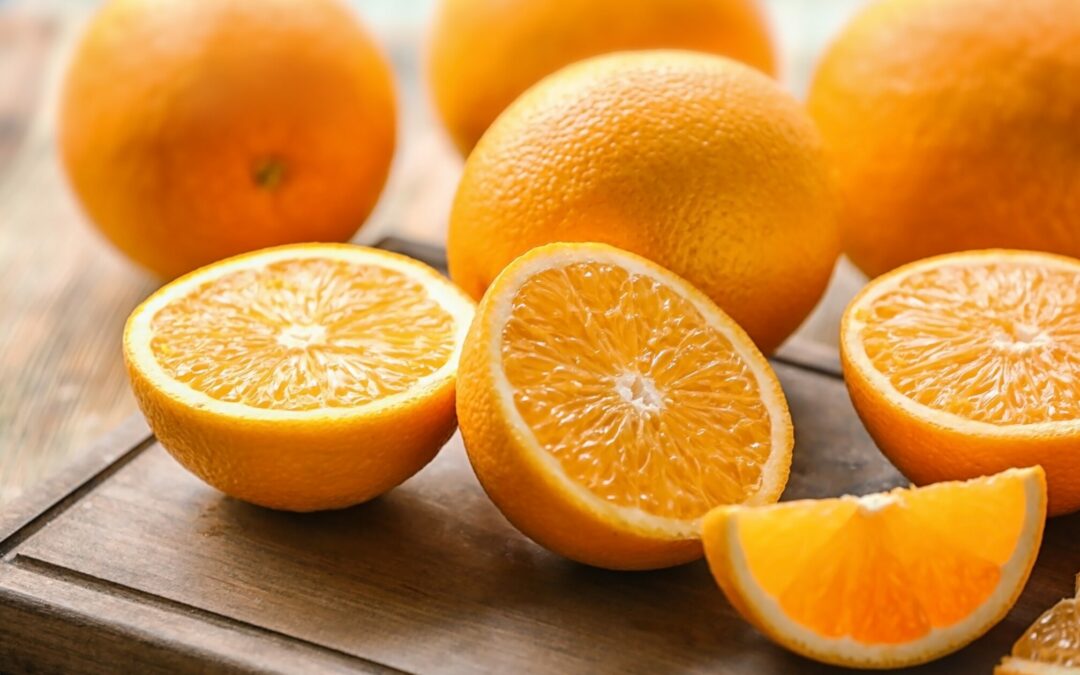
by Angela Braun | Mar 21, 2024 | Bodycare, Preserving
As you know – at least if you’ve read my About Me Page – I work at a school. There, we have a contract with a local grocery distributor who delivers organic fruit or vegetables once a week for the pupils in primary school. Depending on the produce and size, some moms come over and chop the fruit (or veggies) into smaller pieces so that nothing gets wasted.
Last week, we got oranges, and I rubbed my hands with glee. When the moms came to prepare the oranges, I asked them to put the peels aside for me and in the end I got 2 bags full. My office smelled like an orange farm!
I was astonished, though, that they had never heard of the different uses for orange peel and so I decided this topic was worth a blog post. Just let me say this before you dive in: it is important and cannot be stressed enough that you solely use ORGANIC orange peels. Traditionally cultivated oranges contain way too many toxins, especially on the peels and the disadvantages outweigh the benefits by far.
#1 Candied orange peel
For decades I loathed candied orange peel because I only knew the store-bought version. It didn’t look or taste anything like orange at all and even today I’m not sure if there is anything remotely orange in it (except, perhaps, some artificial orange colour). Whenever I made Christmas cookies, gingerbread or other traditional baked Christmas goods that required candied orange peel, I either left it out completely or mixed it with fresh orange juice to a paste so that I would get in some of the flavours. Yet, I was never satisfied until I tried some at a local market in Italy. It was heaven! Juicy and chewy and bursting with flavour. Back home, I researched recipes for making candied orange peel by myself and you’ll be happy to know that it isn’t difficult at all!
Cut the orange peels into strips of about 0.5 cm.
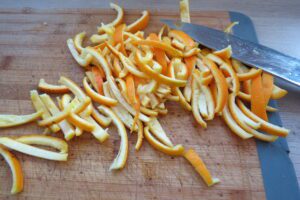
If you want to dry them afterwards and use them as snacks, leave them like that. If you want to use them in cakes or cookies, cut them up into tiny squares.
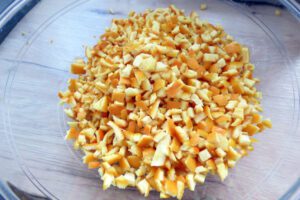
Now, put them into a pot and fill up with water so that the peels are covered. Bring to the boil and let it boil for about 10 minutes. Pour the peels into a sieve and let them drain. Repeat the whole process twice and rinse the peels. This pre-cooking removes the bitter taste from the peels.
Put 0.5 l water into the pot and add 1 kg sugar or multiply the amounts if you have lots of peel. Just stick to the ratio of one part water to two parts sugar. Bring this mixture to the boil while constantly stirring until the sugar is dissolved. When the syrup is boiling add the orange peels and let it simmer for about 30 minutes until the peels are well cooked. Now, you either take the peels out onto a wire rack and let them dry for 12 – 24 hours until they are almost dry and still a bit sticky. Then put some sugar into a bowl, add the peels in portions and mix it through until the peels are well-covered in sugar. In the fridge, they will last for up to one week.
The other option is to put the cooked orange peel cubes into a glass jar and add some of the orange syrup so that the peels are covered in it. Close the jars with lids and once cooled down put them into the fridge. They’ll last for up to one year.
#2: Orange syrup
Don’t throw away the syrup from the candied orange peels. It’ll make an amazing flavour addition to water, cocktails, soda and more. You can even add it to some apple vinegar, pour about 20 cl in a glass and fill it up with sparkling water. This makes a wonderfully refreshing, non-alcoholic drink for summer.
#3: Orange sugar
For this recipe, you must remove the white part of the peel. Cut the peel into pieces, mix it with sugar and put it into a blender. Mix until the sugar and peel are powdery. Distribute it on a baking tray and let it dry in the oven at low heat until it’s completely dry. Let it cool down and store it in a tight container. Basically, it’ll last forever but it’s best consumed within a year of making it. Later, the flavour will go down.
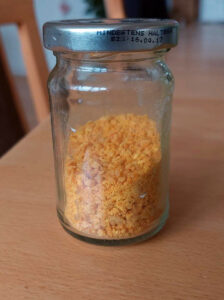
#3: Orange powder
The production of orange powder is similar to orange sugar. You remove the white part of the peel and let the peels dry in the oven at low heat. When they are completely dry (make the “snap test”) and cooled down, grind them in the blender until they’ve become a powder. Use orange powder wherever you need a bit of orange flavour, i.e. cakes, salad dressings or savoury dishes.
#4: Orange salt
Remove the white part of the orange peels and cut them into very small pieces. Put the salt, the orange peels, some thyme and rosemary in layers into a glass jar and close it with the lid. After two weeks, the salt has taken on the flavours. You can either let it be as it is (this will make for a beautiful gift) or put the mixture in a blender and mix it until it’s powdery.
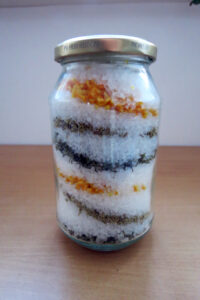
#5: Infused orange oil
To make infused orange oil, remove the white part of the orange peels and put them into a glass bottle. Fill up with very good olive oil and let it set for two weeks. Afterwards, drain the oil and remove the peels. You now have some great orange-flavoured oil that you can use for salad dressings, pasta sauces or even on your pizza.
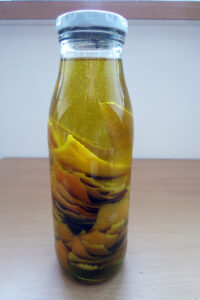
#6: Orange-flavoured honey
Again, remove the white part of the orange peels and put the peels into a glass jar. Fill it up with honey – either the real thing or one of your homemade herb kinds of honey – and let it sit for 5 – 7 days. Drain the honey and use it in your tea or instead of sugar in a German Hefezopf for example.
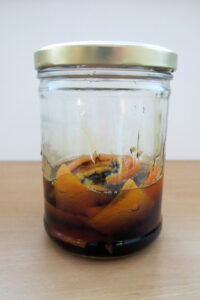
#7: Orange butter
After removing the white parts of the orange peels, cut them into tiny pieces. Soften the butter by mixing it and then add the tiny orange peels and some salt. Mix well and form a roll. Let it sit in the fridge until it’s firm. Enjoy this butter on some homemade bread or with grilled meat. You can also freeze the orange butter so that you’ll have it available when the BBQ season starts. In the fridge, the butter will last for about one week, and in the freezer for up to 6 months.
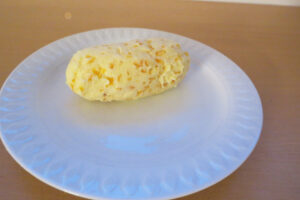
#8: Ice cubes
This is a simple one: remove the white part of the orange peels, cut them into small strips and put them into ice cube forms. Fill up the forms with water and put them into the freezer. I love these orange ice cubes for all kinds of drinks as they don’t water them down but give them a subtle orange flavour.
#9: Orange peel vinegar cleaner
I love cleaning with this orange peel vinegar cleaner. Not only does it remove stains well, but it also smells really good – not at all like vinegar. To make your own orange peel vinegar cleaner, put some orange peels into a large jar until it’s about three-quarters full. Fill it up with white vinegar or vinegar essence and let it sit for two weeks. Remove the peels and fill the cleaner into a spray bottle. You can use this cleaner for removing water stains in the bathroom or for cleaning your kitchen surfaces. In short: everywhere you would use vinegar to clean.
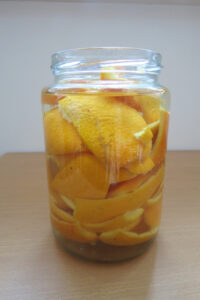
#10: Orange extract for cleaning
After having removed the white part of the orange peels, put the peels in a glass bottle until it’s about three-quarters full. Fill it up with clear alcohol like vodka or schnapps and let it sit for two weeks. After that time remove the peels and put the bottle without a lid onto a sunny windowsill. The alcohol will evaporate. Sniff the mixture from time to time: if you can’t smell the alcohol any longer it’s ready. I love using this orange extract in my mop water and in our homemade laundry detergent.
#11: Orange sugar scrub
This is a fast, cheap and easy way to make a healthy body scrub with totally natural ingredients that will do your body nothing but good! Remove the white part of the orange peels and cut the peels into tiny pieces. Mix them with one cup of coconut oil, ½ cup of sugar and 3-4 tablespoons of orange juice. Put it into a glass and store it in the fridge for up to one week.
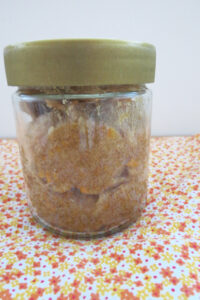
#12: Orange peel soap
As in the orange sugar scrub, finely cut orange peel makes a good peeling in soap, too. You can use any simple soap recipe, add finely cut dried (!) orange peel and some essential orange oil and use it as a peeling soap that smells great! For a simple orange peel soap recipe look here.
I know there are some more uses for orange peels out there but I haven’t tried them yet. I will, however, and every time I find some new ways to use orange peels, I’ll update this post. Stay curious!




























